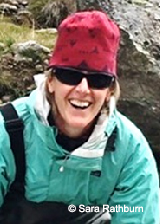336172







Key note speakers

Michael Manga, UC Berkeley, Hydrological responses to earthquakes
The presentation will address how different regions of the subsurface, from shallow unconsolidated sediment to deep fractured basement rocks, respond to stresses produced by Earthquakes. Observations to probe these interactions include changes in the water level and temperature in wells and the amount of water flowing in streams. High temporal resolution of water level changes in Long Valley caldera, California, are used to develop a model for seismic pumping of fluids between fractures.
The presentation will address how different regions of the subsurface, from shallow unconsolidated sediment to deep fractured basement rocks, respond to stresses produced by Earthquakes. Observations to probe these interactions include changes in the water level and temperature in wells and the amount of water flowing in streams. High temporal resolution of water level changes in Long Valley caldera, California, are used to develop a model for seismic pumping of fluids between fractures.

Ed Tipper, Cambridge University, earthquake perturbation of sediment and weathering fluxes
Extreme events such as earthquakes scar landscapes. In mountainous regions earthquakes trigger land slides. These landslides perturb or perhaps dominate sediment delivery to rivers in areas of high uplift and erosion. To finger print the significance of this process a better understanding of sediment source and transport processes. This talk will review evidence for change in sediment source, flux and transport following major earthquakes and consider their importance in the delivery of matter from mountain regions.
Extreme events such as earthquakes scar landscapes. In mountainous regions earthquakes trigger land slides. These landslides perturb or perhaps dominate sediment delivery to rivers in areas of high uplift and erosion. To finger print the significance of this process a better understanding of sediment source and transport processes. This talk will review evidence for change in sediment source, flux and transport following major earthquakes and consider their importance in the delivery of matter from mountain regions.

Sara Rathburn, Colorado State University, precipitation, sediment and carbon transport
Extreme events are predicted to increase in step with climate change, altering Earth surface processes and landscapes. Of particular concern are disturbances that increase sediment delivery from hillslopes to channels because of the effects of increased sedimentation on aquatic ecosystems, channel and floodplain morphology, and water resource management including water quantity and quality. Within the last seven years, extreme flooding, wildfire, and mass movements have occurred within in the Front Range of Colorado, USA resulting in widespread hillslope erosion, morphologic channel change and avulsion, sediment pulse evolution and transport, and extensive deposition. Nested scales of analysis of flood effects from the September 2013 storms will be presented for two rivers; one burned by wildfire in 2012, and one unburned to evaluate channel recovery and sediment transport. The different pathways of recovery provide important insight into landscape resilience to future extreme events.
Extreme events are predicted to increase in step with climate change, altering Earth surface processes and landscapes. Of particular concern are disturbances that increase sediment delivery from hillslopes to channels because of the effects of increased sedimentation on aquatic ecosystems, channel and floodplain morphology, and water resource management including water quantity and quality. Within the last seven years, extreme flooding, wildfire, and mass movements have occurred within in the Front Range of Colorado, USA resulting in widespread hillslope erosion, morphologic channel change and avulsion, sediment pulse evolution and transport, and extensive deposition. Nested scales of analysis of flood effects from the September 2013 storms will be presented for two rivers; one burned by wildfire in 2012, and one unburned to evaluate channel recovery and sediment transport. The different pathways of recovery provide important insight into landscape resilience to future extreme events.

Karen Gran, University of Minnesota Duluth, fluvial recovery after volcanic eruptions
Mount Pinatubo, Philippines, erupted in June 1991, in the second biggest eruption of the 20th century. River valleys filled with pyroclastic flow deposits that were not hot enough to weld, leading to massive redistribution of sediment by lahars following the eruption. We studied channel recovery and evolution for two decades following the eruption, tracking sediment-laden channels as lahars ceased and normal fluvial processes were finally able to process and rework the channel bed. The Pinatubo eruption thus offered a unique look into how rivers process high volumes of sand-rich sediment, providing insights into river recovery following landslides, dam removals, or other extreme sediment-producing events.
Mount Pinatubo, Philippines, erupted in June 1991, in the second biggest eruption of the 20th century. River valleys filled with pyroclastic flow deposits that were not hot enough to weld, leading to massive redistribution of sediment by lahars following the eruption. We studied channel recovery and evolution for two decades following the eruption, tracking sediment-laden channels as lahars ceased and normal fluvial processes were finally able to process and rework the channel bed. The Pinatubo eruption thus offered a unique look into how rivers process high volumes of sand-rich sediment, providing insights into river recovery following landslides, dam removals, or other extreme sediment-producing events.

Brian Buma, University of Denver, ecosystems disturbance and coupling with landscapes
Landslides result from complex interactions between geology, climate, weather, and a host of other factors – including the ecological aspects of the region. Vegetation plays a significant role in hillslope stabilization (with different species providing different aspects of protection), but it can also promote sliding by transferring horizontal wind forces to the ground. Furthermore, vegetation is often manipulated by people. Thus, the integration of the ecology of landslides with our geological understanding is important.
Landslides result from complex interactions between geology, climate, weather, and a host of other factors – including the ecological aspects of the region. Vegetation plays a significant role in hillslope stabilization (with different species providing different aspects of protection), but it can also promote sliding by transferring horizontal wind forces to the ground. Furthermore, vegetation is often manipulated by people. Thus, the integration of the ecology of landslides with our geological understanding is important.

Flavio Anselmetti, University of Bern, earthquakes and sediment records
Instrumental and historic records cover only insufficiently the time span to provide critical information on maximum intensity and recurrence rates of natural hazards. Therefore, geologic archives are needed to expand the temporal coverage of disturbances to prehistoric time scales. Lake sediments, in particular, provide the high-resolution and continuous archives that may identify prehistoric disturbances. Due to their sensitivity to record hazards such as earthquakes, rock falls, floods and tsunamis, lacustrine systems allow long, detailed and quasi-complete catalogues providing critical data for deterministic or probabilistic hazard assessments.
Instrumental and historic records cover only insufficiently the time span to provide critical information on maximum intensity and recurrence rates of natural hazards. Therefore, geologic archives are needed to expand the temporal coverage of disturbances to prehistoric time scales. Lake sediments, in particular, provide the high-resolution and continuous archives that may identify prehistoric disturbances. Due to their sensitivity to record hazards such as earthquakes, rock falls, floods and tsunamis, lacustrine systems allow long, detailed and quasi-complete catalogues providing critical data for deterministic or probabilistic hazard assessments.

Jamie Howarth, Victoria University of Wellington, earthquake cycles and carbon fluxes
Erosion of biospheric particulate organic carbon (POC), export by rivers and subsequent burial in ocean depocentres affects the atmospheric carbon reservoir over geological timescales. Quantifying POC fluxes from extreme events has proved challenging because responses to them often persist beyond the duration of instrumental data series. We overcome this challenge by using sedimentary archives of earthquake-induced erosion. These records show that large earthquakes can significantly contribute to both carbon export from mountain forests and burial in the deep ocean over millennia timescales providing a direct link between active tectonics and the surface carbon cycle.
Erosion of biospheric particulate organic carbon (POC), export by rivers and subsequent burial in ocean depocentres affects the atmospheric carbon reservoir over geological timescales. Quantifying POC fluxes from extreme events has proved challenging because responses to them often persist beyond the duration of instrumental data series. We overcome this challenge by using sedimentary archives of earthquake-induced erosion. These records show that large earthquakes can significantly contribute to both carbon export from mountain forests and burial in the deep ocean over millennia timescales providing a direct link between active tectonics and the surface carbon cycle.